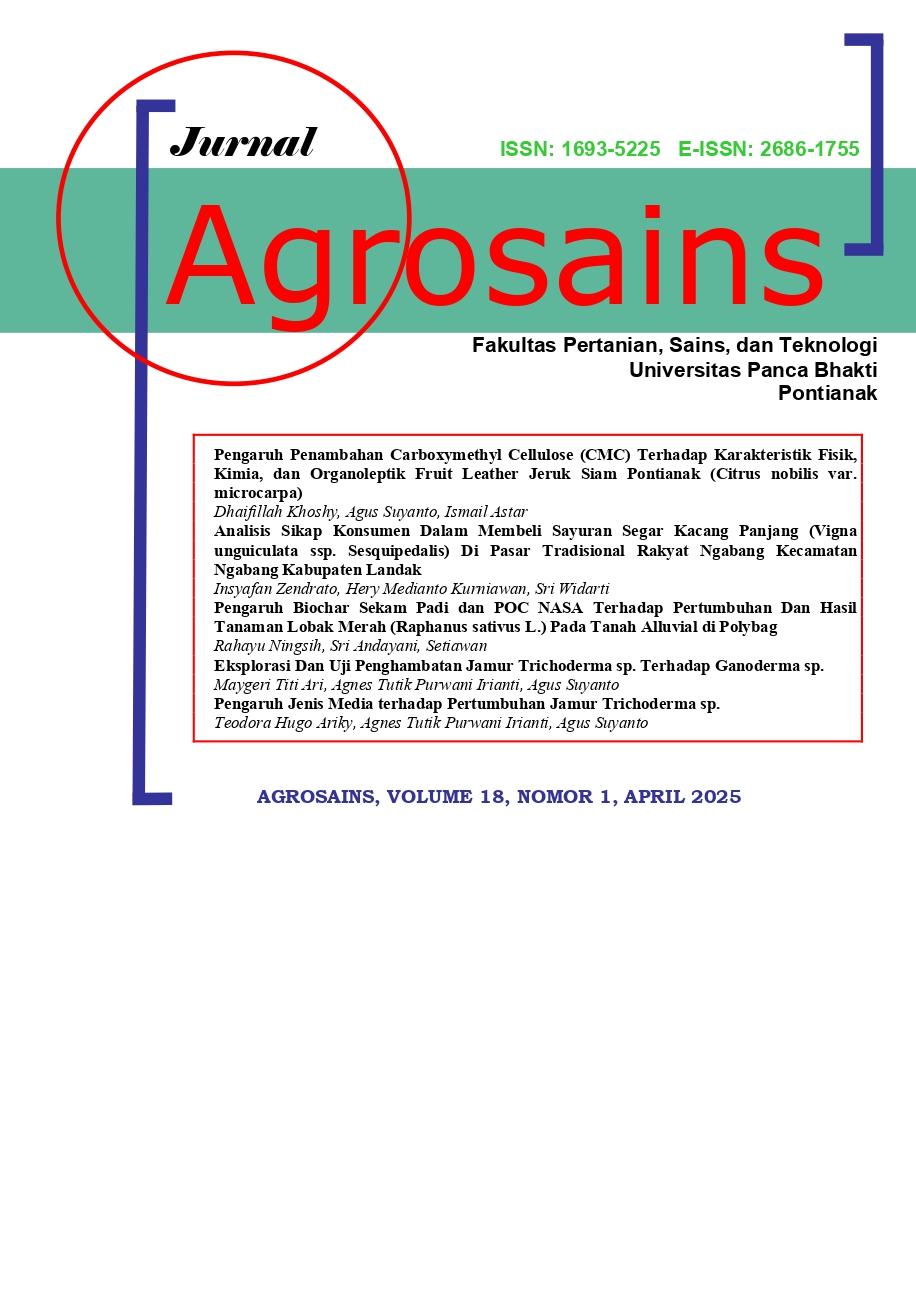Pengaruh Penambahan Carboxymethyl Cellulose (CMC) Terhadap Karakteristik Fisik, Kimia, dan Organoleptik Fruit Leather Jeruk Siam Pontianak (Citrus nobilis var. microcarpa)
Isi Artikel Utama
Abstrak
This research aims to determine the effect of adding CMC to the quality of Pontianak siamese orange fruit leather. The innovation in making Pontianak Siamese orange fruit leather is an effort to process Siamese oranges to extend shelf life and increase their selling price. This research was used a single factor completely randomized design method with six treatments and four replications. The treatment of the concentrations of CMC are 0% w/w; 0.1% w/w; 0.3% w/w; 0.5% w/w; 0.7% w/w and 0.9% w/w for 100 g of total material. All samples of Pontianak siam orange fruit leather were analyzed physically, namely textural analysis (hardness) and chemical analysis, namely proximate analysis including moisture, ash, and vitamin C content, as well as organoleptic tests using the hedonic preference test method. The results showed that the average hardness test (texture analyzer) was 0.19 kgf, the moisture content was 7.31%, the ash content was 1.49%, and the vitamin C content was 0.16%. The influence of adding CMC could be knowm by analyzed it with SPSS 16 with One Way Anova 0,05 and for acceptance were used hedonic rank, if there are some differences, Duncan were used. The result of One Way Anova were showed that was significant on increasing water content, ash content, and vitamin C content. However, this did not significantly affect of hardness of fruit leather. The addition of CMC also has an effect on the organoleptic characteristics of the taste attributes. However, it did not significantly affect texture, color, aroma, and overall attributes. The results of the organoleptic test showed that the 0.7% CMC treatment as a whole had a high percentage of each assessment attribute. Meanwhile, based on the physical and chemical characteristics, the best formulation was the 0.3% CMC treatment because it had the highest vitamin C content of 0.22% and a good hardness of 0.23 kgf and a moisture content of 7.00% and a low ash content. of 1.31%.
Rincian Artikel

Artikel ini berlisensi Creative Commons Attribution-NonCommercial-NoDerivatives 4.0 International License.
Referensi
Anshori, J. A., Julaeha, E., Mayanti, T., Supratman, U., & Hayashi, H. (2006). Senyawa lumonin dari biji jeruk Citrus nobilis var. microcarpa (jeruk siam) dan potensi aktivitasnya sebagai penghambat tumbuh larva instar ke-empat nyamuk Aedes aegypti. Riset dan Teknologi Pembangunan Perekonomian sebagai Salah Satu Pilar Ketahanan Nasional, Bandung.
Aryani, I., Malle, S., & Reta. (2022). Inovasi pembuatan fruit leather buah jeruk pamelo (Citrus maxima) dengan penambahan kulit buah naga. Agrokompleks, 22(1), 24–33.
Badan Pusat Statistik Provinsi Kalimantan Barat. (2020). Kalimantan Barat dalam angka 2019. Pontianak: BPS.
Direktorat Budidaya Tanaman Buah. (2006). Standar prosedur operasional (SPO) jeruk siam Pontianak Kabupaten Sambas Kalimantan Barat. Jakarta: Direktorat Budidaya Tanaman Buah.
Herlina, H., Belgis, M., & Wirantika, L. (2020). Karakteristik fisikokimia dan organoleptik fruit leather kenitu (Chrysophyllum cainito L) dengan penambahan CMC dan karagenan. Jurnal Agroteknologi, 14(2), 103.
Khairunnisa, A., Atmaka, W., & Widowati, E. (2015). Pengaruh penambahan hidrokoloid (CMC dan agar-agar tepung) terhadap sifat fisik, kimia, dan sensoris fruit leather semangka (Citrullus lanatus). Jurnal Teknosains Pangan, 4(1).
Kurniadi, M., et al. (2022). The effect of kappa-carageenan and gum Arabic on the production of guava-banana fruit leather. Journal of Food Science and Technology, 59(11), 4415 - 4426. https://doi.org/10.xxxx
Nurkaya, H., Amran, Marwati, Khotimah, K., & Numarini, E. (2020). Karakteristik organoleptik dan sifat kimia fruit leather nanas (Ananas comosus L. Merr) dengan penambahan karagenan dan gelatin sebagai gelling agent. Buletin LOUPE, 16(2), 17–25.
Puspaningrum, L., Yuwono, S. S., & Martati, E. (2018). Karakteristik fisikokimia dan sensoris fruit leather apel manalagi (Malus sylvestris Mill) dengan substitusi pisang candi (Musa paradisiaca). Jurnal Teknologi Pangan, 19(3), 173–182.
Sarwono. (1994). Budidaya tanaman jeruk. Jakarta: Bumi Aksara.
Setyaningsih, D., Apriyantono, A., & Sari, M. P. (2010). Analisis sensori untuk industri pangan dan agro. Bogor: IPB Press.
Sidi, N. C., Widowati, E., & Nursiwi, A. (2014). Pengaruh penambahan karagenan pada karakteristik fisikokimia dan sensoris fruit leather nanas (Ananas comosus L. Merr) dan wortel (Daucus carota). Jurnal Aplikasi Teknologi Pangan, 3(4), 122–127.
Sulistyoningsih. (2011). Gizi untuk kesehatan ibu dan anak. Yogyakarta: Graha Ilmu.
Tantono, E., Effendi, R., & Hamzah, F. H. (2017). Variasi rasio bahan penstabil CMC dan gum arab terhadap mutu velva alpukat. JOM Faperta, 4(2), 1–15.
Winarno, F. G. (2004). Kimia pangan dan gizi. Jakarta: Gramedia Pustaka Utama.
Yudhistira, B., Putri, R. A. A., & Basito. (2020). Pengaruh carboxymethyl cellulose (CMC) dan gum arab dalam velva buah naga super merah (Hylocereus costaricensis). Journal of Agro-based Industry, 37(1), 20–29.

